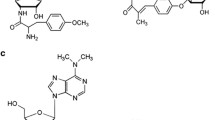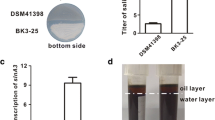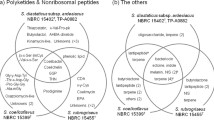Abstract
An incomplete oligoketide (PK; ‘polyketide’) gene cluster, aur1, responsible for the production of an angucycline-like antibiotic auricin was identified in Streptomyces aureofaciens CCM 3239. A region downstream of the aur1 was cloned and sequenced, revealing 28 new genes encoding putative protein products involved in deoxysugar biosynthesis and other putative PK-related biosynthetic functions. In addition, a gene, bpsA, encoding a protein similar to non-ribosomal peptide synthetases (NRPSs) was identified in this region. A deduced protein product of the gene showed the highest similarity to NRPSs IndC from Erwinia chrysanthemi and BpsA from Streptomyces lavendulae, both involved in the biosynthesis of a blue pigment indigoidine. S. aureofaciens CCM 3239 was found to produce an extracellular blue pigment with identical properties as indigoidine. A deletion mutant of bpsA in S. aureofaciens CCM 3239 failed to produce the blue pigment. In addition, the deletion of bpsA had a positive effect on auricin production. The results indicate the involvement of the bpsA gene in biosynthesis of the indigoidine blue pigment in S. aureofaciens CCM 3239.
Similar content being viewed by others
Abbreviations
- CFU:
-
colony forming unit(s)
- DIG:
-
digoxygenin
- DMF:
-
dimethylformamide
- DMSO:
-
dimethylsulfoxid
- NMP:
-
N-methylpyrrolidone
- NRPS:
-
non-ribosomal peptide synthetases
- ORF:
-
open reading frame
- PCR:
-
polymerase chain reaction
- PK:
-
oligoketide (‘polyketide’)
- PKS:
-
oligoketide (‘polyketide’) synthase
- THF:
-
tetrahydrofurane
- WT:
-
wild type
References
Ausubel F.M., Brent R., Kingston R.E., Moore D.O., Seidman J.S., Smith J.A., Struhl K.: Current Protocols in Molecular Biology. Wiley, New York 1995.
Bibb M.J.: Regulation of secondary metabolism in streptomycetes. Curr.Opin.Microbiol.8, 208–215 (2005).
Evans G.A., Lewis K., Rothenberg B.E.: High efficiency vectors for cosmid microcloning and genomic analysis. Gene79, 9–20 (1989).
Gust B., Challis G.L., Fowler K., Kieser T., Chater K.F.: PCR-targeted Streptomyces gene replacement identifies a protein domain needed for biosynthesis of the sesquiterpene soil odor geosmin. Proc.Nat.Acad.Sci.USA18, 1541–1548 (2003).
Horinouchi S., Hara O., Beppu T.: Cloning of a pleiotropic gene that positively controls biosynthesis of A-factor, actinorhodin, and prodigiosin in Streptomyces coelicolor A3(2) and Streptomyces lividans. J.Bacteriol.155, 1238–1248 (1983).
Kieser T., Bibb M.J., Buttner M.J., Chater K.F., Hopwood D.A.: Practical Streptomyces genetics. The John Innes Foundation, Norwich (UK) 2000.
Kuhn R., Starr M.P., Kuhn D.A., Bauer H., Knackmuss H.J.: Indigoidine and other bacterial pigments related to 3,3′-bipyridyl. Arch.Microbiol.51, 71–84 (1965).
Lee Y.A., Yu C.P.: A differential medium for the isolation and rapid identification of a plant soft rot pathogen, Erwinia chrysanthemi. J.Microbiol.Methods64, 200–206 (2005).
Novakova R., Bistakova J., Homerova D., Rezuchova B., Kormanec J.: Cloning and characterization of a polyketide synthase gene cluster involved in biosynthesis of aproposed angucycline-like polyketide auricin in Streptomyces aureofaciens CCM 3239. Gene297, 197–208 (2002).
Redenbach M., Kieser H.M., Denapaite D., Eichner A., Cullum J., Kinashi H., Hopwood D.A.: A set of ordered cosmids and a detailed genetic and physical map for the 8 Mb Streptomyces coelicolor A3(2) chromosome. Mol.Microbiol.21, 77–96 (1996).
Reverchon S., Rouanet C., Expert D., Nasser W.: Characterization of indigoidine biosynthesis genes Erwinia chrysanthemi and role of this blue pigment in pathogenicity. J.Bacteriol.184, 654–665 (2002).
Rouanet C., Nasser W.: The PecM protein of the phytopathogenic bacterium Erwinia chrysanthemi, membrane topology and possible involvement in the efflux of the blue pigment indigoidine. J.Mol.Microbiol.Biotechnol.3, 309–318 (2001).
Starr M.P., Cosens G., Knackmuss H.-J.: Formation of the blue pigment indigoidine by phytopathogenic Erwinia. Appl.Microbiol.14, 870–872 (1966).
Takahashi H., Kumagai T., Kitani K., Mori M., Matoba Y., Sugiyama M.: Cloning and characterization of a Streptomyces single module type non-ribosomal peptide synthetase catalyzing a blue pigment synthesis. J.Biol.Chem.282, 9073–9081 (2007).
Wright F., Bibb M.J.: Codon usage in the G+C rich Streptomyces genome. Gene113, 55–65 (1992).
Author information
Authors and Affiliations
Corresponding author
Rights and permissions
About this article
Cite this article
Novakova, R., Odnogova, Z., Kutas, P. et al. Identification and characterization of an indigoidine-like gene for a blue pigment biosynthesis in Streptomyces aureofaciens CCM 3239. Folia Microbiol 55, 119–125 (2010). https://doi.org/10.1007/s12223-010-0018-5
Received:
Revised:
Published:
Issue Date:
DOI: https://doi.org/10.1007/s12223-010-0018-5




